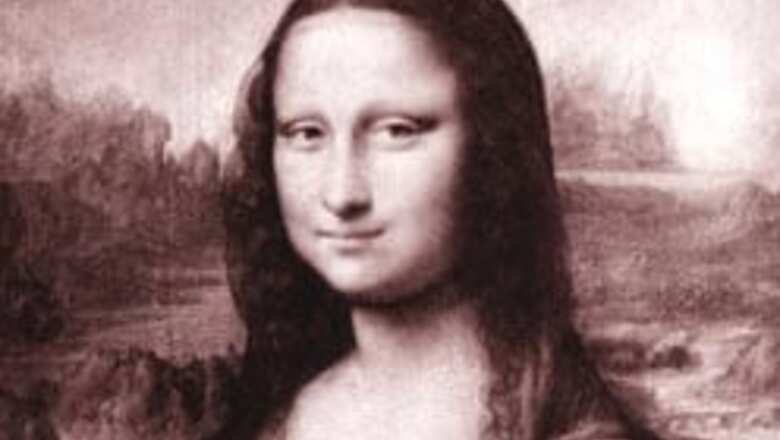
views
Hong Kong: He has painted the Mona Lisa everyday for the past two years, copying the masterpiece from a faded page torn out from an art book, and the artist is more than a little besotted by his subject and her enigmatic smile.
"Sometimes I forget to eat or sleep when I am painting her. I forget everything except her face," said Wen Xiao Qiang, 33, as he put the finishing touches to a copy that took him two days to paint, and which he will send to a client in Germany for $25.
"There is a pain behind her smile that I want to understand but I can't. Sometimes it frustrates me so much that I want to tear my work into pieces."
A peasant farmer's son who gave up rice trading when he discovered his talent for art, Wen has no idea what century or what country his subject comes from. Nevertheless, he feels he knows her more intimately than any artist alive, and his loving reproductions have won him a reputation as the finest Mona Lisa artist in a grey concrete suburb of southern China called Dafen Art Village, home to more than 6,000 painters.
The works of these artists fill the living room walls of the world. If you see reproduction oil painting in a hotel corridor or restaurant wall, there's a good chance it comes from Dafen.
In a distinctly unromantic setting on the outskirts of the sprawling industrial city of Shenzhen, painters as young as 15 work for around $380, between them producing hundreds of thousands of replica masterpieces a month for Dafen's 600 galleries and exporters with buyers in Britain, Europe and the US.
In the galleries, you can buy a small copy of Van Gogh's Sunflowers for $2 or have a family photograph turned into a framed oil painting for $38. You can even have yourself painted into the Last Supper.
China has merged its twin talents for counterfeiting and mobilising cheap labour to turn the art market into a production line industry - and just as typically - its ruthless efficiency and low prices have driven competitors in Asia and around the world out of business.
It is a working environment that gives painters little time to contemplate their art. In one three-floor workshop, fifty young artists, most of them young girls, work for company boasts of exporting 10,000 paintings a month.
It meets its quotas by employing factory-style production techniques, using teenage apprentices to paint the backgrounds and hiring skilled painters to apply the foreground and key features.
"It takes five hours on average for each painting, and we sell them to overseas buyers for 65 yuan ($8.2) each," said general manager Bin Den.
"Buyers send us the pictures they want by e-mail and we just copy them. We never ask what the paintings are and the girls never want to know. They are just doing their job."
The industrial-level output is a galaxy away from the original concept of Dafen, which was set up 20 years ago by a group of young artists as a bohemian commune for struggling painters waiting for their genius to be discovered.
Slowly, the ability of its artists to produce good, cheap counterfeits spread, and the quantum leap came with the Internet.
Now buyers no longer need to visit to place orders. They simply send in orders online and have them shipped out within weeks at a fraction of the price of hiring artists in western countries.
The Chinese government recognised its profit potential and now promotes Dafen at overseas trade fares.
Art college graduates and self-taught painters from across southern China flooded in as demand grew and Dafen's artist population has doubled in the past five years.
Today many of the galleries are finding a rich new stream of revenue in portrait painting, turning family photographs sent by e-mail into oil paintings.
China's breed of nouveau-riche businessmen is also providing lively business, having their faces painted into classical portraits to hang in their modern villas.
At Li Ya Yuen's gallery, an artist was painstakingly adding the face of a businessman from Guangzhou to a giant painting of the 19th century US president Thomas Jefferson. It is a task that takes seven days to complete and will cost the businessman 1,200 renminbi ($150).
Other businessmen have had their features added to paintings of George Washington, Tsar Nicholas II of Russia, and the famous painting of Napoleon on horseback at the Grand-Saint-Bernard pass.
"They like them because it makes them look powerful," said Li.
The wives come too, sometimes choosing to be transformed into a classic, but mostly looking for a makeover, which will portray them as Marilyn Monroe with her skirt blowing up in the air.
For Wen, however, there is and probably always will only be one likeness to capture. As we walk past his studio on our way out of Dafen, he runs up clutching a sheet of sketch paper covered with neat handwriting.
It is a love letter to the Mona Lisa, telling her how he thinks of her everyday and wishes he could be with her.
"One day, when I have earned enough money, I want to go to see the real painting," he tells us. "I just want to see her more clearly. Then I will feel closer to her and paint her better.
"To me, she looks like a beautiful woman from China's Tang Dynasty. She doesn't look like a western woman."
With that, he ducks back into his tiny studio, picks up his brush and returns to his easel to try once again to capture the smile of the woman who has crossed centuries, cultures and continents to haunt him.
















Comments
0 comment